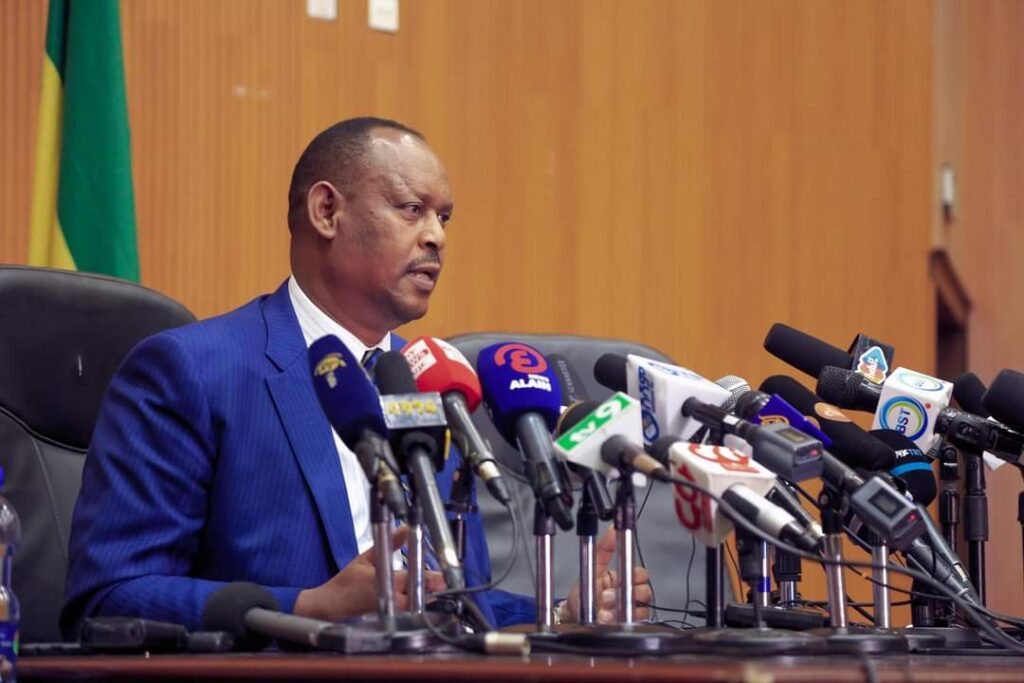Mr. Mitiku Kassa, Commissioner for the National Disaster Risk Management Commission of the Federal Democratic Republic of Ethiopia (#NDRMC) gave a briefing to the media today (February 09) on recent developments in the #humanitarian assistance process in the #Tigray region, coordination mechanism among stakeholders and efforts underway to enable aid recipients a recovery from their current situation. Mr. Tesfahun Gobezay, Director General at Agency for Refugees and Returnees Affairs (#ARRA) has also given a briefing on the situation of #Eritrean refugees.
Mr. Mitiku Kassa’s briefing on #Humanitarian assistance in Tigray
==========
Humanitarian assistance
– 1.8 million people were registered as aid recipients before the commencement of the law enforcement operation, of whom 1.2 million belong to the Safety Net program, 600 thousand in a relief package while 100 thousand as internally displaced people.
– According to data collected by a team, composed of Tigray’s interim government, bi-laterals, international NGOs, and aid organizations 700 thousand people are identified as who require humanitarian assistance making the total number of people who need humanitarian aid 2.5 million
– 34200 quintal of food, 60 thousand kilos of sugar, 20 thousand kilos of wheat with WFP’s transportation assistance have been distributed to affected people
– 690, 000 quintals of wheat has been distributed to those who are covered under the Safety Net package
– 70% of delivery has been conducted by the federal Government while Tigray’s REST covered the remaining
– Distribution and on time unloading of goods, in addition to some unruly people who prohibit people from taking the already provided aid have been observed as problems,
– The delivery of Non-food items is underway with the support of 10 international NGOs
– 28 regions outside of Mekelle have been reached with humanitarian supply until yesterday
– The Commission took the margin of 4.5 million people as aid recipients in calculating the worst-case scenario (and people who inflate the number do not understand the workings of the commission)
Coordination mechanism
– 10 clusters have been established based on international standards- eg. A cluster on Nutrition which includes NGOs and emergency coordination center in Mekelle
– 26 government organizations are part of these clusters
– Coordination among stakeholders is getting good day by day
Recovery works
– A recovery and peacebuilding team is established to give a long-term solution to the problem (i.e., they are working on getting people out of their current situation)
Mr. Tesfahun Gobezay’s briefing on #Eritrean Refugees
============
– He begins his briefing by recalling Ethiopia’s commitment to the safety and protection of refugees. He said Ethiopia is renowned for hosting 1 million refugees from 27 countries (mainly from neighboring countries) by constructing camps in 27 areas. Unfortunately, he said, the refugees are camped in Ethiopian regions that do not have adequate provisions compared to the national standard. However, in a way that shows our commitment, we have continued to host the refugees.
– Among the total of Eritrean refugees in Tigray, 75% of them are sheltered in Adi Harush and Mai Aini camps and they are getting the necessary supply on time
– Only 19000 Eritrean refugees were in Shimelba and Hitsat refugee camps, of whom, we have currently created active contact with more than 10, 000. This doesn’t mean that the remaining have vanished or forcibly returned to their country as many have claimed. We can easily identify them with their electronic identity cards and more than 300 are reporting to us per day. And many of them are also dispersed in different parts of the country.
– Shimelba camp is located 20 KM away from Eritrea which has been contested since its establishment because at least the refugees should be relocated 50 km away from the border of their country of origin as per international standards. And Hitsats is found in a very inhospitable area for human beings to lead a reasonably normal life; it is in the very area (Dedebit) where the junta tried to hide. Both of the camps are located in areas where the government took active law enforcement operations. The government of Ethiopia has tried to relocate the refugees in these camps to another area had it not been for the stubborn refusal of the TPLF clique that was administering the region before the beginning of the law enforcement operation. Some of these refugees have been relocated to the remaining two camps that host Eritrean refugees while the others are dispersed in Addis Ababa, Tigray (Shiraro, Badime, Adi Hageray, Shere areas) and Amhara regions (Gonder, Debarq, Dessie, Woreta)
MoFA






